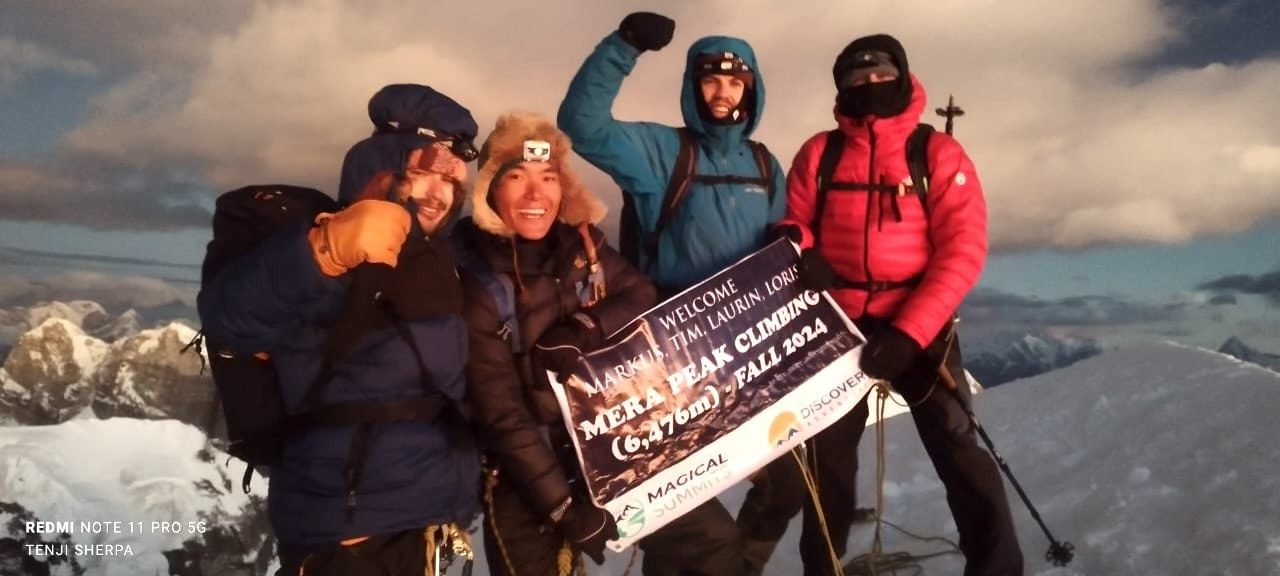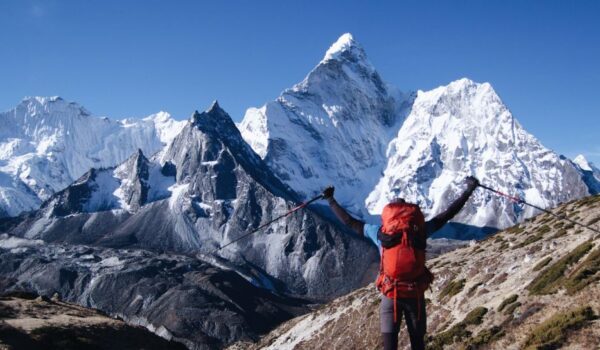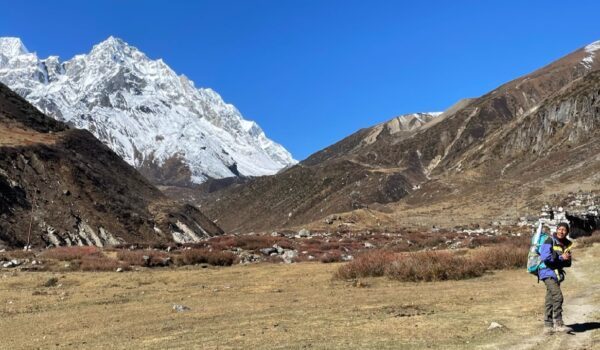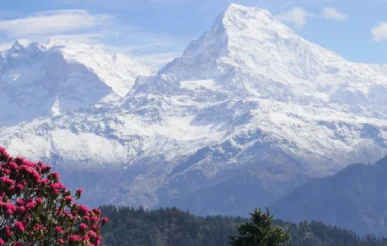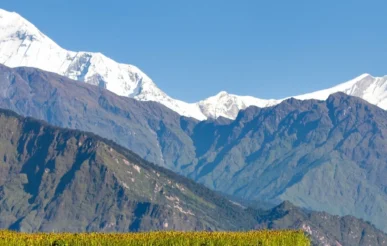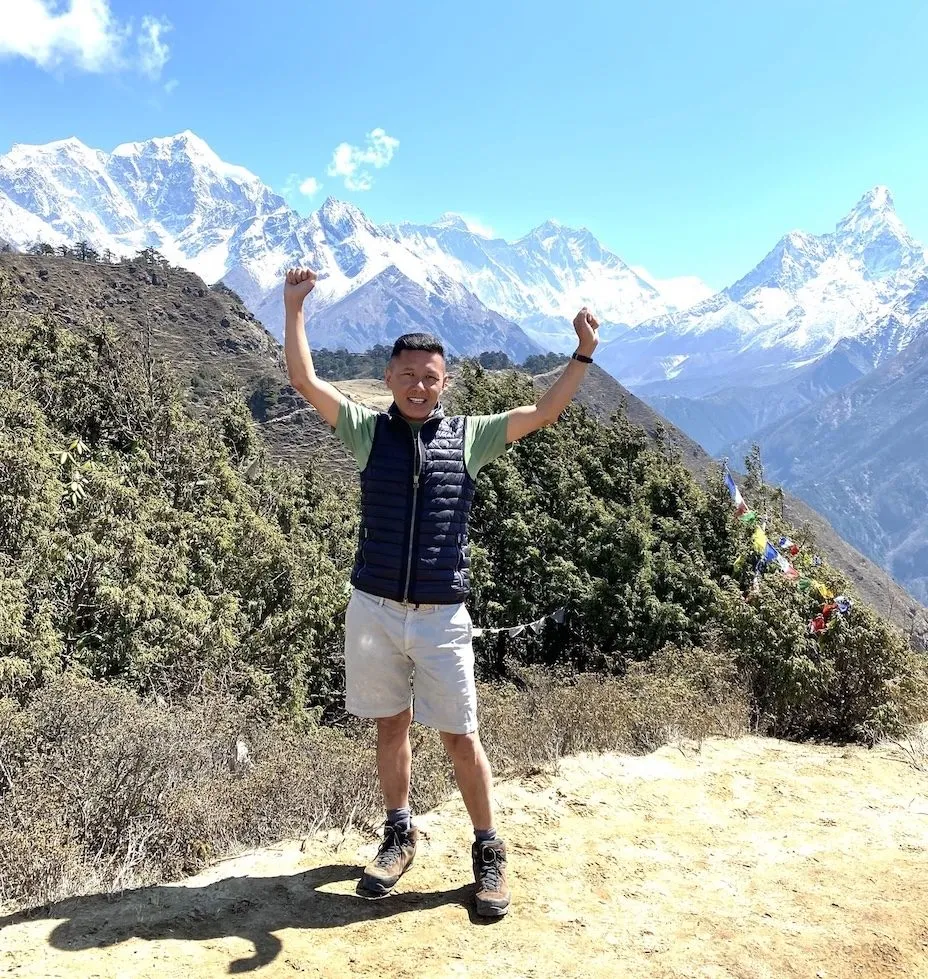Island Peak vs Mera Peak
Island Peak or Mera Peak? This question is asked by many Himalayan adventurers, with good reason. On the surface, Island Peak and Mera Peak are two trekking peaks in the Everest region of Nepal, so they look rather similar, but they will provide two very different routes and two very different journeys.
Both of these peaks are Himalayan icons. They can provide what will be not only a nice challenge for travelers (both new and experienced), but will guarantee a remarkable introduction to the wild and majestic wilderness of Nepal. Climbing Mera Peak or Island Peak is the climbing equivalent of trekking-style journey to Everest Base Camp, Manaslu, or Annapurna, which is a rite of passage for other trekkers.
Both mountains are located in the Everest region and definitely offer challenges for adventurers – but they are different. First, Mera Peak. Mera Peak is 6,476m and is the highest trekking peak in Nepal; it’s really a great view and fairly easy, relative to the mindset of a climber. Apart from altitude, the most basic thing that climbers need to be able to do is acclimatize; nonetheless, these peaks represent what the technical standard is. Because of safety techniques of acclimatization by the guides, a climber who is a technical novice, fit, and has a fair degree of competence could manage.
Conversely, Island Peak is 6,189m, yet it is a much more technical climb. When you are climbing, the incline is much steeper, and the climber will have to negotiate a very exposed ice wall using ropes and crampons, meaning this peak is designed for folks who really want the mountaineering experience.
We’ll talk about Island Peak vs Mera Peak below so you can make the right decision prior to commencing your climbing adventure in Nepal.
Island Peak Vs Mera Peak Facts
| Category | Island Peak (Imja Tse) | Mera Peak |
| Elevation | 6,189 m | 6,476 m |
| Location | Khumbu Himal, Everest region | Hinku Valley, Mahalangur Himalaya |
| First Ascent | Southwest summit in 1953; main in 1956 | Central summit on May 20, 1953 |
| Difficulty Grade | PD+ (some steep ice, headwall, ladders, exposed ridge) | PD (mostly glacier/snow; less technical) |
| Technical Challenges | Crevasse ladders, fixed ropes, exposed ridge, steeper ice | Gentle glacier climb; basic crampon/axe use |
| Trek & Climb Duration | 14–19 days total (including trek & summit push) | 18–22 days total |
| Typical Climb Days | 1–2 summit push days | 3 summit push days |
| Best Season | Spring & Autumn (Apr–May, Sep–Nov) | Same (Mar–May, Sep–Nov) |
| Panoramic Views | Close-up of Lhotse/Everest walls, Ama Dablam | 360° panorama: Everest, Lhotse, Makalu, Cho Oyu, Kanchenjunga |
Introduction to Island Peak
Island Peak (or Imja Tse) at 6,189m, in the Everest region of Nepal, is one of the most well-known trekking peaks in Nepal. It is given its name because, when viewed from Dingboche, it looks like an island in a sea of ice.
Island Peak sets the stage for the perfect beginner mountaineering experience for experienced climbers as well as adventurous trekkers.
The adventure includes beautiful trekking through Khumbu valley, the thrill of glacier crossings, and a final short, but steep ridge. Once summit, the reward is one of the most spectacular views of Everest, Lhotse, Makalu, and Ama Dablam a sunrise.
Island Peak is a fun adventure while showcasing Sherpa culture and the beauty of Sagarmatha National Park.
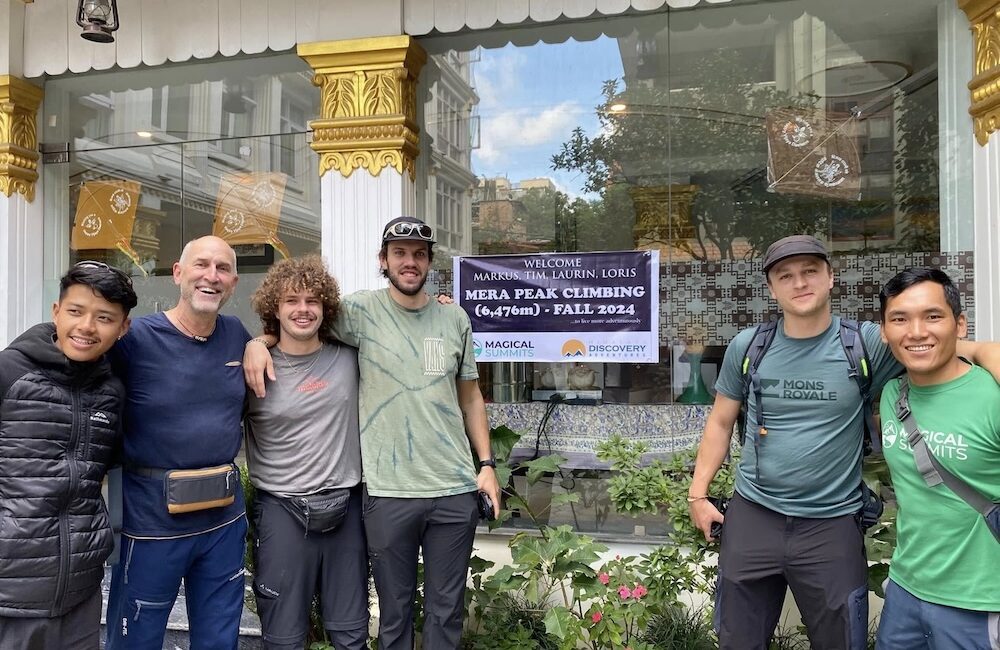
Mera Peak Introduction
At nearly 6,476 m elevation, Mera Peak is the highest officially designated trekking peak in Nepal; in fact, it is the highest trekking peak in the Mahalangur Himalaya of the Everest region.
While Mera is high, climbing it is non-technical and moderate (Alpine grade PD), primarily snow and glacier walking with only a few crevasse crossings, then it steepens and employs fixed ropes (and normally crampons and ice-axe).
On summit day, climbers leave at 1–2 a.m. to walk from base camp to top camp, then summit and back in one extended 8-9 hour day. When climbers reach the high point on Mera Peak, they are normally rewarded with 360° views of no less than five 8,000 m giants: Everest, Lhotse, Cho Oyu, Makalu, and Kangchenjunga, surrounded by a sea of neighbouring Himalaya peaks.
Significant Highlights of Island Peak Climbing
- Trek starts off with a lovely flight to Lukla, and then a trek through the untamed Hinku Valley.
- Walk through typical Sherpa villages such as Paiya, Panggom, and Khare, where people can meet the locals and learn about their way of life.
- The rest day at Khare includes generalized mountaineering practice; thus, climbers are better equipped for attempts at reaching the summit.
- Glacier walking, use of ropes, crampons, and ice axes make the non-technical ascent suitable for beginners with good fitness.
- The peak provides a sweeping view of Everest, Lhotse, Makalu, Cho Oyu, and Kanchenjunga.
- Indeed, a full immersion into the realm of the Sherpa culture is gained through the installations of the various traditional events that are held, as well as the visits to the monasteries.
- Trek is a mix of different scenery like subtropical forests, alpine meadows, and glaciers.
- Accommodation in teahouses and tented camps offers the best of both worlds – the comfort.
What are the Highlights of Mera Peak Climbing?
- Rewards climb to the highest peak in Nepal at 6,476 meters.
- Offers a panoramic view of Everest, Lhotse, Makalu, and Kanchenjunga.
- The trekking route goes through the beautiful Sherpa villages.
- Opportunity to have a close interaction with the locals and get some insights into their traditions.
- Experience of crossing suspension bridges and going up the steep mountain ridges.
- Trails that lead across the rich rhododendron forests, the glacial water rivers, and the remote valleys that reveal the pure Himalayan wilderness.
- Evenings in the real teahouses and campsites, tasting the Sherpa cuisine, and enjoying the hospitality.
- Good opportunity for spotting the Himalayan wildlife and also for watching the yaks’ caravans that are moving in their natural environment
- Going to base camp for trekking consists of some days for getting used to the place and enjoying the beautiful sunrise.
- It is a climb that gives the option of easy mountaineering along with minimal ice-axe and crampon skills.
Accessibility
While Island Peak and Mera Peak suffer the same limitations and challenges due to both being remote in the Himalayas, they have completely different routes of access. Island Peak is in the Everest region, close to Chhukung, and the route to the summit follows the classic Everest Base Camp route. Most climbers will fly into Lukla and walk the normal trail to Namche Bazaar, Dingboche, and up to Chhukung. These routes are more well-trodden and logistics and support systems are readily available, with lots of teahouses along the way. These routes will also be much more crowded with trekkers and climbers.
Mera Peak is in a more off-the-beaten-path area of the Hinku Valley that can be approached either by flying to Lukla and following a longer, harder trail south, through Paiya and Khote, or, for those in a hurry, by getting dropped slightly north of from Lukla trail. The trek is quieter, and although there are teahouses along the way, not as many, and not as equipped as on the Island Peak trek, there are still opportunities for tea and food along the trek.
Generally, Island Peak is likely to be much easier for any number of reasons: close proximity to the very busy Everest trail, better infrastructure, while Mera Peak will take time, taking a long, quiet, off-the-road, remote route, wanting to connect with quietness, but perhaps more work to get to it.
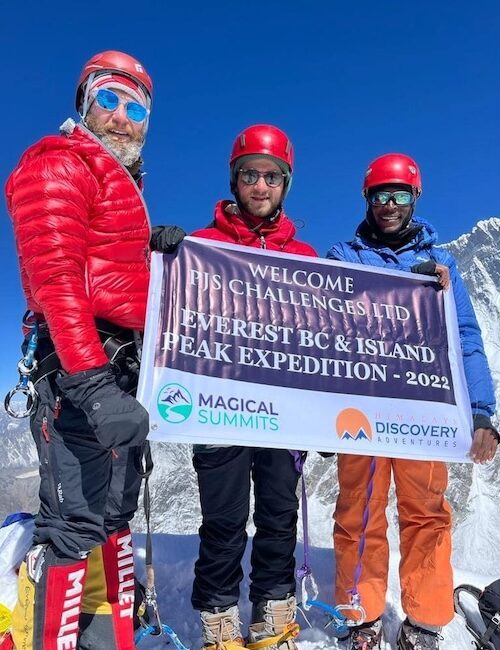
Elevation Island Peak vs Mera Peak
Mera Peak is Nepal’s highest trekking peak at 6,476 meters, so as measured by altitude, it is taller than Island Peak or Imja Tse, which is at 6,189m. In fact, Mera Peak is a full 287 meters taller than Island Peak. Both peaks are awesome Himalayan adventures, but climbing them is an entirely different experience at altitude. Because Mera Peak is higher, for most travelers, it will take a longer time to acclimatize to higher altitude when climbing.
Island Peak is shorter, but there are generally steeper sections and more technical climbing. Although there are also acclimatization sections to consider, as far as altitude, when you have to consider technical climbing, Mera Peak would be better for trekkers who just want the highest altitude; Island Peak is for climbers who do not care about altitude, just technical climbing.
Breakdown of Island Peak Climbing Elevation Gain by Day
| Day | Route | Start Elevation | Max Elevation | End Elevation | Elevation Gain |
| 1 | Arrive in Kathmandu | 1,400m | 1,400m | 1,400m | – |
| 2 | Free / Permits & gear check | 1,400m | 1,400m | 1,400m | – |
| 3 | Fly to Lukla → Trek to Phakding | 1,400m | 2,860m | 2,610m | +1,460m / -250m |
| 4 | Phakding → Namche Bazaar | 2,610m | 3,440m | 3,440m | +830m |
| 5 | Acclimatization: Explore Namche or hike to Everest View | 3,440m | 3,880m | 3,440m | +440m / -440m |
| 6 | Namche → Tengboche | 3,440m | 3,860m | 3,860m | +420m |
| 7 | Tengboche → Pheriche | 3,860m | 4,240m | 4,240m | +380m |
| 8 | Pheriche → Lobuche | 4,240m | 4,910m | 4,910m | +670m |
| 9 | Lobuche → Everest Base Camp → back to Gorakshep | 4,910m | 5,364m | 5,164m | +454m / -200m |
| 10 | Gorakshep → Kala Patthar → Dingboche | 5,164m | 5,545m | 4,410m | +381m / -1,135m |
| 11 | Dingboche → Island Peak Base Camp | 4,410m | 5,100m | 5,100m | +690m |
| 12 | Summit Island Peak (6,189m) → Return to Base Camp | 5,100m | 6,189m | 5,100m | +1,089m / -1,089m |
| 13 | Base Camp → Dingboche | 5,100m | 4,410m | 4,410m | -690m |
| 14 | Dingboche → Namche Bazaar | 4,410m | 3,440m | 3,440m | -970m |
| 15 | Namche Bazaar → Lukla | 3,440m | 2,860m | 2,860m | -580m |
| 16 | Fly to Kathmandu | 2,860m | 1,400m | 1,400m | -1,460m |
| 17 | Free day in Kathmandu | 1,400m | 1,400m | 1,400m | – |
| 18 | Fly home | 1,400m | – | – | – |
Breakdown of Mera Peak Climbing Elevation Gain by Day
| Day | Route | Start Elevation | Max Elevation | End Elevation | Elevation Gain |
| 1 | Arrive in Kathmandu | 1,400m | 1,400m | 1,400m | – |
| 2 | Free day: sightseeing, briefing & gear check | 1,400m | 1,400m | 1,400m | – |
| 3 | Fly to Lukla → Trek to Chutok | 2,860m | 2,950m | 2,950m | +1,550m |
| 4 | Chutok → Col Khari → Pangkongma | 2,950m | 3,170m | 2,846m | +220m / -324m |
| 5 | Pangkongma → Kurke | 2,846m | 3,800m | 3,800m | +954m |
| 6 | Kurke → Thuli Kharka | 3,800m | 4,300m | 4,300m | +500m |
| 7 | Thuli Kharka → Kothey (Khothey) | 4,300m | 3,600m | 3,600m | -700m |
| 8 | Khothey → Tangnag | 3,600m | 4,350m | 4,350m | +750m |
| 9 | Acclimatization & rest at Tangnag | 4,350m | 4,600m | 4,350m | +250m / -250m |
| 10 | Tangnag → Khare | 4,350m | 5,045m | 5,045m | +695m |
| 11 | Khare → Mera La → Base Camp | 5,045m | 5,300m | 5,300m | +255m |
| 12 | Base Camp → High Camp | 5,300m | 5,800m | 5,800m | +500m |
| 13 | Summit Mera Peak (6,476m) → Return to Khare | 5,800m | 6,476m | 5,045m | +676m / -1,431m |
| 14 | Spare day (in case of bad weather) | 5,045m | 5,045m | 5,045m | – |
| 15 | Khare → Khothey | 5,045m | 3,600m | 3,600m | -1,445m |
| 16 | Khothey → Thuli Kharka | 3,600m | 4,300m | 4,300m | +700m |
| 17 | Thuli Kharka → Lukla | 4,300m | 4,600m | 2,860m | +300m / -1,740m |
| 18 | Fly to Kathmandu | 2,860m | 1,400m | 1,400m | -1,460m |
| 19 | Free day / Optional flight home | 1,400m | 1,400m | 1,400m | – |
| 20 | Fly to home | 1,400m | – | – | – |
Island Peak vs Mera Peak: Total Trip Duration and Distance
Mera Peak Trek
Trip Duration: 15 – 18 days
- Average Daily Hike: 4 – 6 hours
- Total Distance: Approx 75 km (or 46.6 miles) of hiking.
Most trekking groups or expeditions will typically be able to get the actual Mera Peak trek in the range of about 15 – 18 days, total, including time acclimatizing and soaking up all that experience. The average daily hike time will be in the range of about 4 – 6 hours of hiking during a day, while the distance walked in a day can differ from about 6 km a day to about 13 km a day. Total, the distance of the Mera Peak trek will be in the range of approx. 75 km (or 46.6 miles).
Island Peak Trek
- Trip Duration: 14- 20 days
- Average Daily Hike: 4 – 6 hours
- Total Distance: Approx 100 km (or 62 miles) of hiking.
The average daily trek to Island Peak can vary considerably based on the proposed itineraries and acclimatization. The daily treks will also vary considerably in terms of the average daily trek. Generally, we average about 4 to 6 hours, and distance will average between 6 – 13 kilometers (depending on trail and elevation). Overall, in total, trekkers may experience about 100 kilometers (62 miles) for the trip.
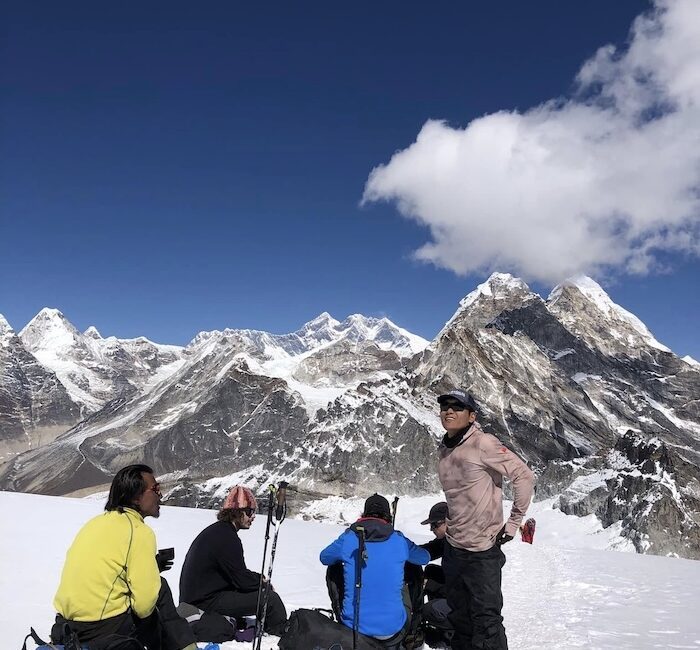
Island Peak vs Mera Peak Difficulty: Which Peak Climbing is Hard?
Although Mera Peak (6,476 m) is a little more elevated than Island Peak (6,189 m), the climb of Island Peak is characterized as a more technical than Mera Peak, for the two climbing experiences are unique, for Island Peak required more technical climbing as it requires the climber to perform basic mountaineering, such as with crampons and ice axe.
In contrast, climbing fixed lines, climbing a crevasse, and steep ice climbs, with the last challenge being the wall of ice at the end. Climbers who want to climb Island Peak must be fit, have acclimatized time on Island Peak, and be fit to climb in the climbing conditions. The final challenge is climbing the last 150 meters on ice on the Ice Head Wall.
Mera Peak, as a mountain, is technically easier. Even though Mera Peak is taller, Mera Peak is classified Alpine Grade PD (Peu Difficile), a “moderate climb with some technical sections”. Although, the route will involve glacier travel, rock climbing with the use of ropes and fixed lines, Mera will not involve technical ice climbing and dealing with exposure to crevasses as in Island Peak.
To summarize, while Island Peak has a technically more difficult ascent that needs real mountain climbers to be successful, Mera Peak is more of a walk-up when good basic mountaineering experience is required.
Success Rate Comparison: Island Peak and Mera Peak
| Year | Island Peak Success Rate | Mera Peak Success Rate |
| 2020 | 70% | 80% |
| 2021 | 75% | 85% |
| 2022 | 80% | 90% |
| 2023 | 85% | 90% |
| 2024 | 85% | 90% |
Island Peak Success Rate
Island Peak (Imja Tse) is one of the most sought-after trekking peaks in Nepal. It has unique technical elements that span a wide range of camping durations. It is located in the Everest Region, which has been a draw for many trekkers.
The success rate for summiting Island Peak ranges from 70% to 85% depending on the source. There are many unique features that can affect success, including the climber’s fitness, technical climbing ability, and days of acclimatization to altitude.
The summit has steep ice slopes, where there are also crevasses (some solvable or supportable crevasses), a final headwall just before the summit (all of these portions require fixed ropes, crampons, and ice axes.
Mera Peak Success Rate
Mera Peak is the highest trekking peak in Nepal, and the summit success rates reported for Mera Peak are usually in the range of 70-90%. In some reports, the summit success is stated as even better.
The main problem is altitude as climbers are going over 6000 meters. Summit success will usually depend on good acclimatization, fitness, as well as a slow and cautious ascent with respect to each climber’s health.
There are some basic mountaineering skills required, but the route is typically fairly straightforward.
Fatalities
Island Peak Deaths
Island Peak (6190 m) is a famous, relatively easy peak. There is just one basic technical section: the steep ice and snow slope. Deaths on Island Peak are rare, but they do happen, and deaths the Island Peak have to do with altitude (so altitude then climbing again), crevasses, and the headwall. Generally, success is achievable with the management of their pace and preparation, and technical challenges of their climbs.
Mera Peak Fatalities
Mera Peak isn’t that technically demanding at 6,476 meters; the only real danger is altitude, and because of the ever-changing weather, which can quickly create dangerous situations. In October 2021, there was a porter who died from altitude sickness during their descent from the summit, and due to heavy snows, many climbers got trapped on Mera, including foreign climbers. A guide also went missing during the storm, and later was discovered dead.
Both have indeed had deaths, mainly from altitude sickness, and other environmental hazards. Island Peak has technical difficulties requiring a higher skill level of climbing ability, while Mera Peak is more of an evaluation of high altitude acclimatization/sickness with possible weather hazards.
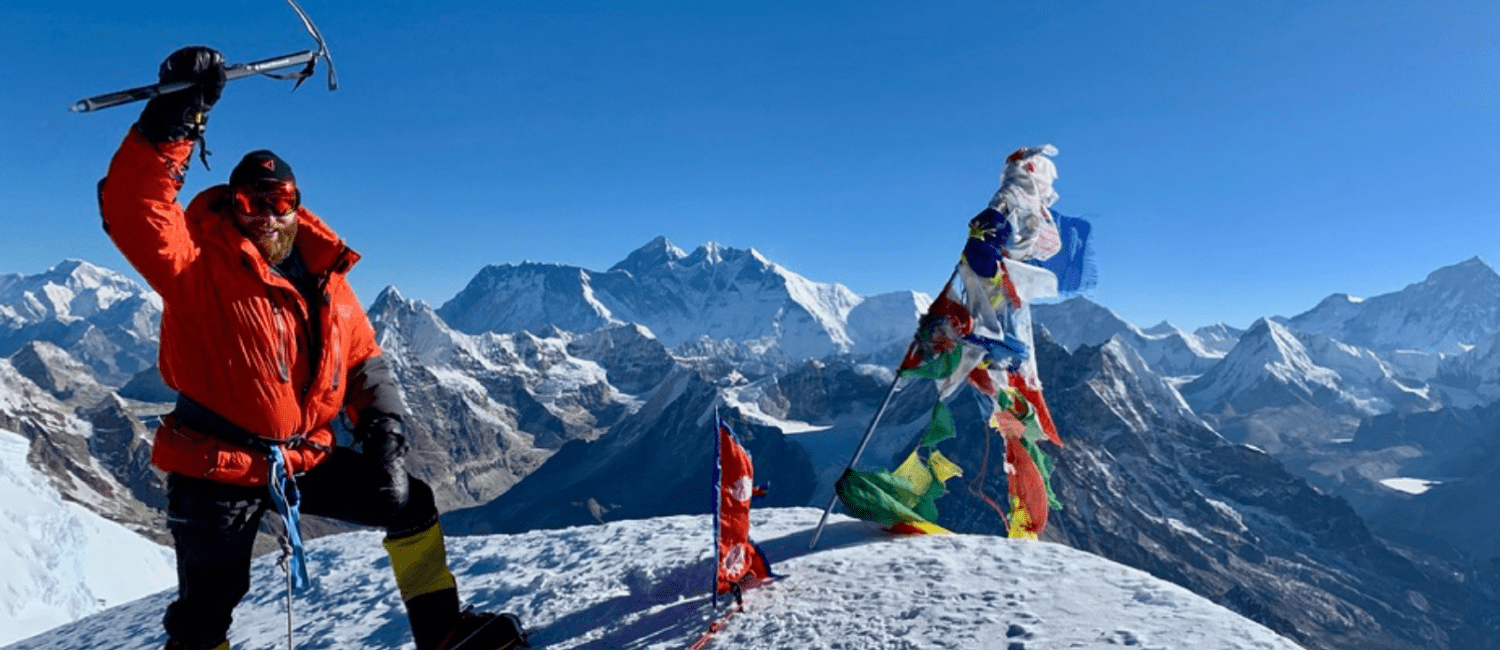
Accommodation Facilities: Island Peak vs Mera Peak
On both Island Peak and Mera Peak, trekkers are offered a combination of teahouse and tented camping experiences as they go up. Still, the kind of facilities and the number of them change with the increase of altitude.
What Kind of Accommodation is Available on Island Peak?
The journey of Island Peak (Imja Tse) trek and climb needs two principal kinds of lodging:
Teahouses/Lodges (Lower Altitude):
- These are in the villages along the approach trek such as Lukla, Namche Bazaar, Pangboche, and Chhukung.
- Teahouses, run by local families, offer simple but comfortable rooms, shared bathrooms, hot meals, and sometimes showers and Wi-Fi at lower elevations.
- Twin sharing is the most common, and you will definitely need a good sleeping bag for those cold nights.
Camping (Base Camp and High Camp):
- At Island Peak Base Camp (around 5,200m) and High Camp (around 5,800m), there are no permanent lodges or teahouses.
- Climbers sleep in sturdy tents, usually two people per tent, set up by support staff.
- Expedition cooks prepare meals in a different dining tent.
- No Wi-Fi nor shower, electricity is thus mostly from solar and very limited.
What Kinds of Accommodation are Available on Mera Peak?
Teahouses/Lodges (Lower & Mid Altitude):
- Located in villages such as Lukla, Paiya, Kothe, and Khare (the last major settlement at ~5,000m).
- Teahouses give simple, clean rooms, sometimes with Wi-Fi, hot food, limited electricity, and occasionally hot showers (usually for an additional fee).
- Khare is the last place with proper lodge/teahouse accommodation before the summit attempt.
Camping (Mera Peak Base Camp and High Camp):
- Over Khare, sleeping arrangements become tented camping, especially so at Mera Base Camp and High Camp (~5,300m–5,800m).
- Professional trekking staff transport and pitch tents for sleep, dining, and also for toilets.
- There is no permanent shelter, no running water, and no electricity; the team prepares the food and the variety depends on what can be carried up.
Cost Differences: Island Peak vs Mera Peak
Generally, climbing Island Peak costs between USD 2000 – 2500 unless your trek includes Everest Base Camp or is a straight non-stop trek from Chhukung. Generally, climbing packages with permits (approx. USD 350), climbing guide, flights to Lukla, hospitality, food, and group climbing/ camping gear will be included.
The climbing Island Peak trek has a shorter timeframe (16-18 days), so it is generally less expensive. One company’s price is USD 2055 for a 15-day package, and other companies say the average package price is about USD 2400 for the EBC Island Peak combo package.
By contrast, climbing Mera Peak is usually more expensive, generally about USD 2,400 – 3000. The costs of a Mera Peak trek is more because of the longer itinerary (18 – 20 days), more remote access to the neighboring mountains via Hinku Valley that adds costs. High altitude trek will incur more costs because food is brought into remote areas, and the average price for the Mera Peak permit fee is usually more, about USD 400.
Essentially, Mera Peak is going to be in the range of 10% to 25% more than Island Peak. Costs associated with Mera Peak are primarily the result of the trek being longer, a more remote approach route to Mera Peak, and poor trekking infrastructure that limited service and support costs like porter and guide planning.

The Thrill
Island Peak is definitely a more exciting climb because of the technical parts crossing crevasses, climbing fixed ropes on a steep headwall, and also handling a narrow summit ridge. It offers a small taste of alpine climbing within a trekking-peak format, just right for the daring first-timers.
Mera Peak, on the other hand, although having a higher altitude, is a less technical snow-covered trail with glacier and gentle slopes. The thrill will be in the gaining of heights and the continuous, unbroken views of the surroundings.
Altitude Sickness
Both peaks go beyond 6,000 m and the danger of altitude sickness is very real. The summiting effort of Island Peak starts at the lower base camp elevations (~5,000–5,600 m); thus, climbers usually receive the benefit of acclimatization along the Everest Base Camp route.
As Mera Peak is a bit higher, it normally involves sleeping at more extreme heights (above 5,800 m); thus, it is possible that if the ascent schedule is too aggressive, the climber becomes very vulnerable to AMS, HAPE, or HACE.
Comfort
The path of Island Peak is comparatively shorter, and it also provides lodge-supported trekking up to Dingboche besides the minimal camping near the high camps, thus better comfort and staging logistics.
Generally, the Mera Peak expedition is a longer trek (15–18 days), trailed by what is normally more camping days or fewer teahouse days, which makes it physically exhausting and less comfortable, but still rewarding in a remote wilderness sense.
Popularity
Island Peak is the most climbed 6,000 m peak in Nepal. It is the favorite of mountaineers because of its proximity to Everest Base Camp and logistical ease; it is bustling with activity during spring and autumn seasons.
Mera Peak, being well-known as the highest trek in Nepal, is not only a trip with fewer people but also more remote, thus quieter trails and less congestion, which is perfect for those who need peace.
